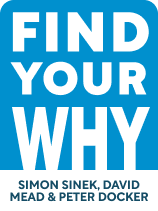

This article is an excerpt from the Shortform book guide to "Find Your Why" by Simon Sinek, David Mead, Peter Docker. Shortform has the world's best summaries and analyses of books you should be reading.
Like this article? Sign up for a free trial here .
What are the best methods for finding your team’s purpose? How can you motivate your team with your purpose?
According to author and motivational speaker Simon Sinek, a team’s core products and services should align with its purpose. Creating a unified team purpose allows you to be more conscientious about where to spend the team’s resources.
Keep reading to learn expert advice for finding and leading with team purpose and how everyone will benefit.
How Individuals and Organizations Benefit From Finding Their Why
Sinek says that making better decisions and being more persuasive benefits individuals, entrepreneurs, and organizations. Let’s explore the specific ways these benefits of having a clear team purpose apply to each group:
1. Individuals: Knowing your purpose helps you get clear on what moves you. It can inject new passion into your work if it’s already fulfilling, or it can direct you toward a more fulfilling path. (Shortform note: Research confirms this. People with a clear sense of purpose experience fewer negative emotions, have a more secure self-image, and earn more money.)
2. Entrepreneurs: A defined purpose helps you identify and appeal to the right potential investors, clients, and customers—those with whom your message will resonate. (Shortform note: In To Sell Is Human, Daniel Pink notes that entrepreneurs must constantly sell their vision to investors, clients, or employees. Believing that what you’re selling serves a larger purpose makes you a more effective salesperson.)
3. Organizations: Knowing your organization’s or team’s purpose helps you in three ways:
First, you can increase the loyalty and creativity of your employees or members by involving them in a common team purpose. This can make your success more sustainable than that of organizations driven solely by profit.
Second, you can create a unifying team purpose by showing your team members the unique role they play within the organization and how they contribute to its broader purpose.
Third, you can more easily find and keep the right people. Having a team purpose means you can hire for what Sinek calls “cultural fit.” This matters because while you can fill skill and experience gaps through training and support, it’s hard to inspire and harness the potential of a team misaligned at its core. (Shortform note: Hiring for cultural fit can devolve into simply hiring people you identify with, which can make your organization’s culture homogeneous and unwelcoming to people from different backgrounds. Some culture experts suggest vetting candidates on specific cultural values and setting up objective frameworks to avoid this pitfall.)
| Additional Benefits of a Team Purpose Besides harnessing a team’s loyalty and creativity, Chip and Dan Heath argue in The Power of Moments that a shared purpose sustains a team through challenges and boredom by keeping their work connected to a larger, meaningful mission. Also, as Gen. Stanley McChrystal explains in Team of Teams, when specific teams share an understanding of how each contributes to the purpose of the organization, they avoid working in silos, pursuing individual goals that hinder the achievement of the larger mission. Finally, Sinek contends that using your purpose to guide hiring decisions helps you avoid defaulting to tribalism. You can seek out people who are aligned with it, regardless of their demographics or affiliations, and take advantage of that diversity to push the mission forward. |
Creating a Team Purpose with Guided Discussion
The goal is to extract two key insights from stories participants will share: the core action the team consistently takes, and the effect the action has on others. To do so, the authors suggest dividing participants into groups that represent the diversity in the room. Avoid teaming people up with the colleagues they work with every day. (Shortform note: As David Epstein argues in Range, people from diverse backgrounds bring different ideas and values to the table, which results in new insights.)
To extract the first insight, begin by asking participants to share with their small groups stories of when they took pride in being part of the team. Then, ask each small group to share their three most emotionally impactful stories with the rest of the team. Ask follow-up questions after each story to uncover its significance. (Shortform note: If a team is struggling to come up with examples, help reframe their thoughts by considering proud moments that they may overlook. In The Power of Moments, Chip and Dan Heath suggest paying attention to small wins and focusing on progress instead of results.)
Ask participants to choose an action verb or phrase for each story they have shared. The verbs should capture the core actions the team took. Finally, ask each group to share what they’ve written while you take notes, highlighting repeated phrases or expressions. (Shortform note: If the team isn’t sure how to translate stories into action verbs or phrases, remind them of another process in which they use verbs and phrases to solidify ideas: writing objectives in action-oriented language. The logic behind both processes is the same. Attaching action words to stories makes the stories more concrete—similar to how action verbs help make objectives actionable, as John Doerr instructs in Measure What Matters.)
To extract the second insight, ask the small groups to share stories of people whose lives changed for the better thanks to the team. Then, ask each group to share their responses with the full group while you write down a phrase from each response that captures the essence of the team’s effect on others; note repeated phrases. (Shortform note: Since the authors encourage participants to focus on the feelings the team generates, rather than the product or services they provide, this could unintentionally make an organization seem more virtuous than it is. Since customers are savvy—and as Sinek argues in Start With Why, they can detect manipulation—you shouldn’t overlook the less sanitized parts of the work you do. This will help ensure your purpose statement is truthful.)
Draft the Purpose Statement
To begin, show participants a sample purpose statement and explain where each part of the statement will come from: The team’s core actions will shape the first part of the statement; the team’s effects on others will shape the second part.
Ask small groups to draft a team purpose statement using the notes from the previous conversations, particularly the repeated phrases and ideas. Each small group should do their own draft. Finally, ask small groups to share their drafts out loud so that all the participants together can decide whether to keep one of the drafts or combine them.
Save all the notes you didn’t use in the final draft of the purpose statement. These are the themes you will use to determine your “How,” or methods.
(Shortform note: To help foster collaboration towards a common team purpose, facilitators can follow Kim Scott’s advice in Radical Candor: Make sure everyone listens to each other and builds on each other’s ideas. Help small groups refine their ideas before sharing them so others will assess them fairly. Stop a conversation if it becomes about “winning” rather than debating. After some debate, transition to decision-making. Remember to leave the decision in the participants’ hands.)

———End of Preview———
Like what you just read? Read the rest of the world's best book summary and analysis of Simon Sinek, David Mead, Peter Docker's "Find Your Why" at Shortform .
Here's what you'll find in our full Find Your Why summary :
- Simon Sinek’s steps to understanding and living your purpose and your organization’s
- How to create and write your purpose statement
- What to do after you find your Why: Determine your How






